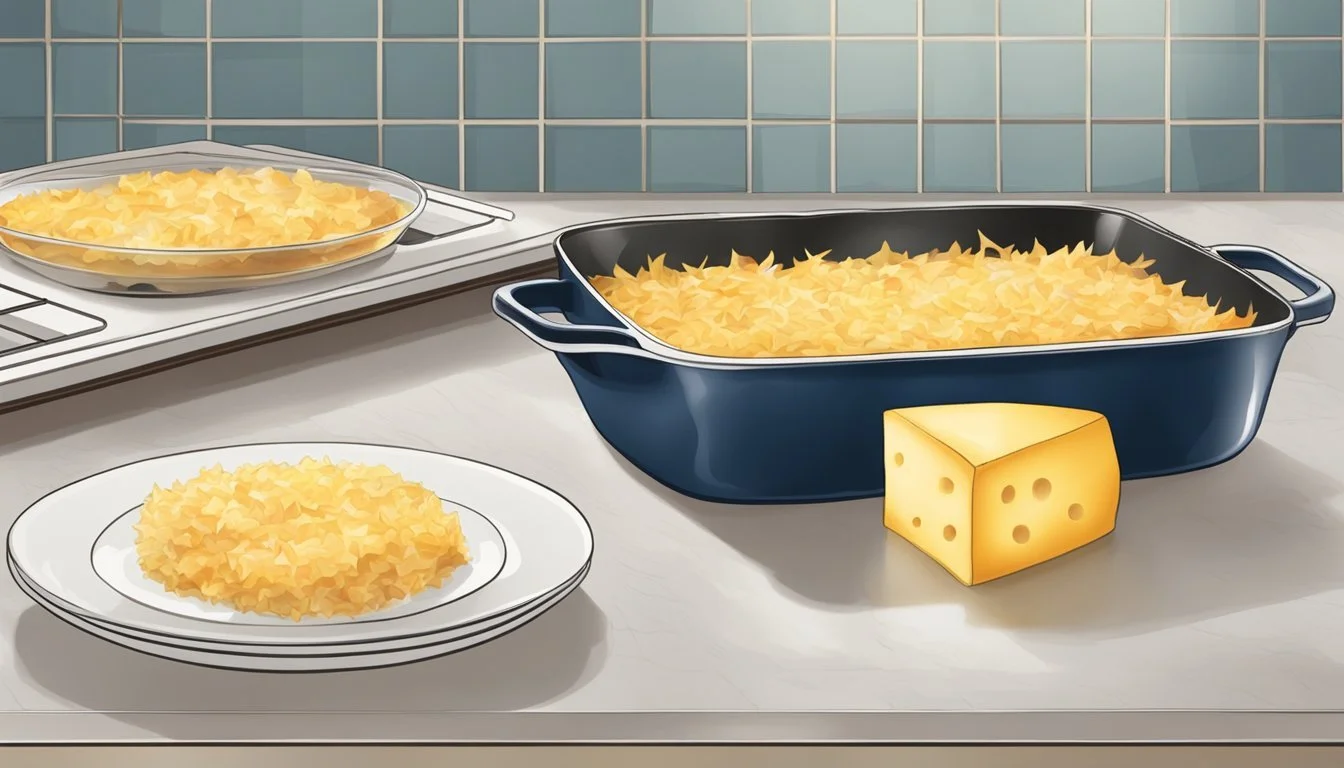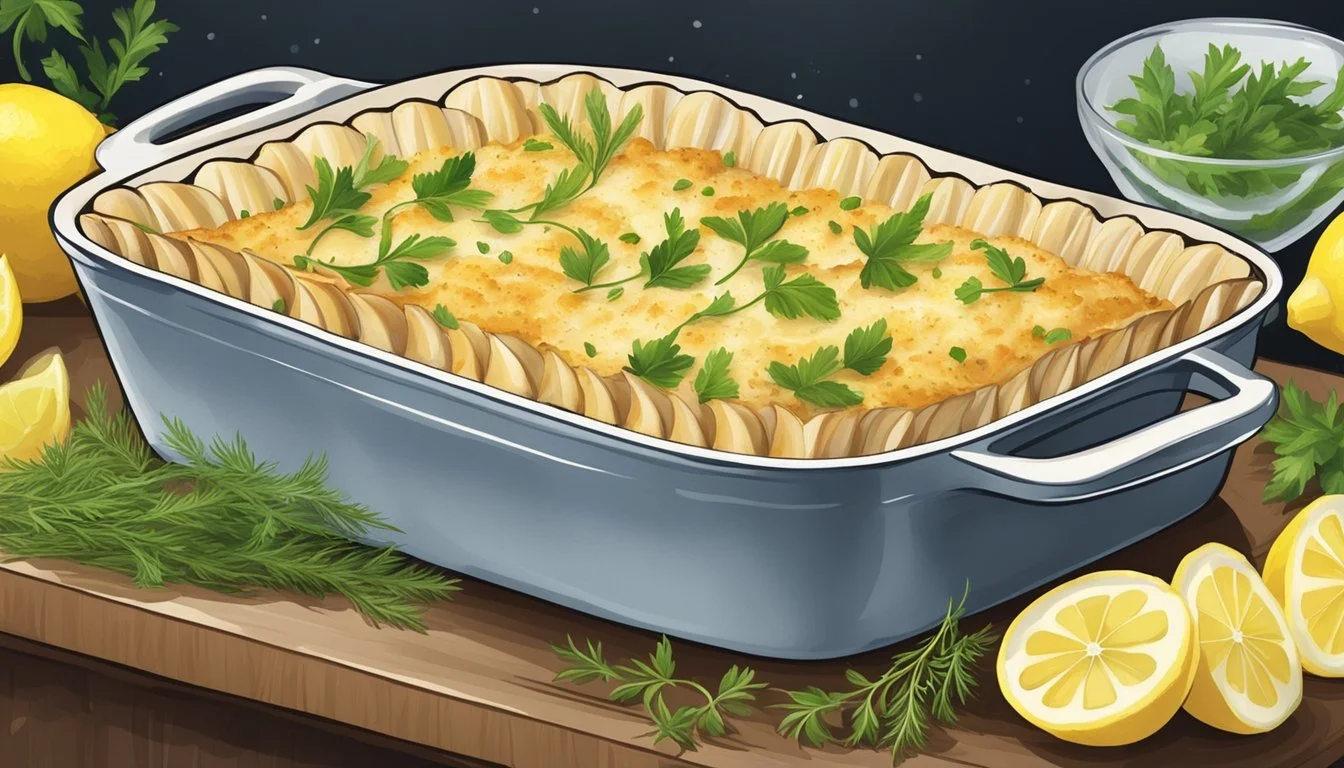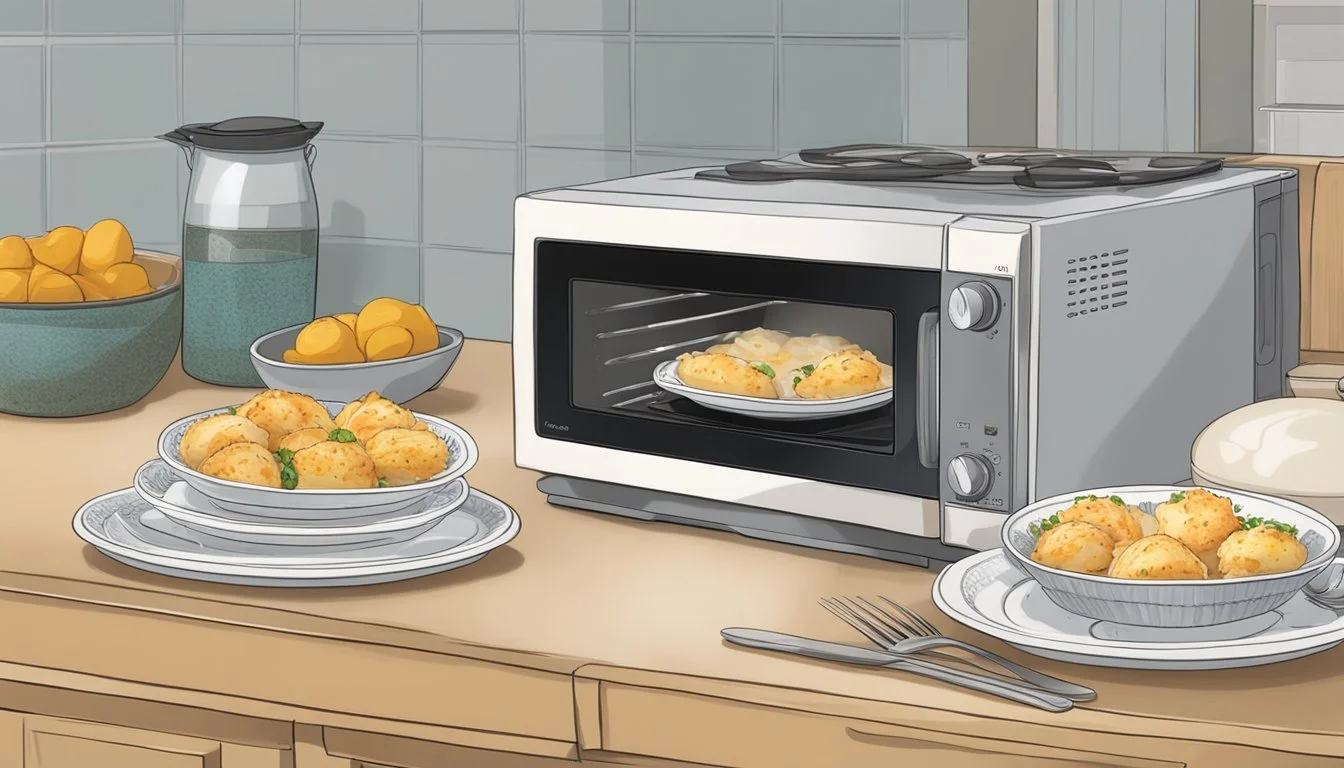How to Reheat Coquilles Saint-Jacques
Expert Tips for Perfect Results
Reheating Coquilles Saint-Jacques, a classic French appetizer and first course featuring tender scallops in a creamy sauce, requires precision to preserve its delicate flavors and textures. To ensure a delightful dining experience, bring the Coquilles Saint-Jacques to an internal temperature of 145°F (62.8°C), measured with a food thermometer. This crucial step helps maintain the dish's safety and quality.
Properly reheating Coquilles Saint-Jacques begins with understanding the storage requirements. Keep the dish refrigerated at temperatures between 32°F to 40°F (0°C to 4.4°C) and avoid repeated reheating to minimize the risk of harmful bacteria growth. These guidelines not only enhance the taste but also ensure food safety.
For the best results, reheat the Coquilles Saint-Jacques slowly and evenly. This can be achieved by placing the dish in an oven preheated to 350°F (175°C) until it reaches the safe internal temperature. This method preserves the creamy sauce’s smoothness and the scallops' tenderness, ensuring each bite is as delicious as when it was first prepared.
Understanding Coquilles Saint-Jacques
Coquilles Saint-Jacques is a classic French dish known for its rich flavors, combining scallops, a creamy sauce, and often baked until golden. This section covers its historical significance, key ingredients, and the essential role of scallops in this delicacy.
Historical Background
Originating from France, Coquilles Saint-Jacques has a long history tied to the country’s culinary traditions. The name "Saint-Jacques" refers to Saint James, the patron saint of pilgrims, indicating the dish's connection to ancient pilgrimage routes.
This recipe has been revered in French cuisine for centuries, highlighting its significance in French culinary heritage. Its popularity surged in the mid-20th century as a staple in festive and formal meals, reflecting its status as a luxurious and celebratory dish.
Key Ingredients
Several key ingredients make Coquilles Saint-Jacques distinctive. Scallops, either sea or bay, are the hero of this dish, providing a sweet and tender texture. Unsalted butter is essential for creating the rich sauce that coats the scallops. Mushrooms add an earthy flavor that complements the sweetness of the scallops.
To enhance the sauce, white wine and cream are commonly used, enriching the dish with depth and a creamy consistency. Finally, gruyère cheese tops the creation, offering a savory finish when baked to a golden brown.
Scallops: Sea or bay scallops
Butter: Unsalted
Mushrooms
Wine: White
Cream
Cheese: Gruyère
The Role of Scallops
Scallops are the foundation of Coquilles Saint-Jacques, dictating the dish's flavor profile and texture. Sea scallops are preferred for their larger size and sweeter taste, while bay scallops offer a more delicate flavor. Scallops need to be cooked precisely to maintain their tenderness and avoid becoming rubbery.
When preparing Coquilles Saint-Jacques, the freshness of the scallops is paramount. Fresh scallops possess a subtle sweetness and tender consistency crucial to the dish’s success. Pan-searing the scallops in butter provides a caramelized exterior that enhances the overall flavor before they are incorporated into the creamy sauce.
Scallops play a central role not only in the preparation but in the final presentation, contributing to the dish’s luxurious and refined appeal. Their natural sweetness pairs wonderfully with the cream and wine, creating a balanced, flavorful experience.
Preparation Before Reheating
To ensure your Coquilles Saint-Jacques is perfectly reheated, proper preparation steps are essential. This involves safely thawing the scallops, preheating the oven to the correct temperature, and having all necessary utensils ready.
Thawing the Scallops
If your Coquilles Saint-Jacques was frozen, thawing is the first critical step. Place the scallops in the refrigerator at a temperature of 32°F to 40°F (0°C to 4.4°C) for 12-24 hours. Avoid thawing at room temperature to minimize the risk of bacterial growth.
For a quicker method, you can place the scallops in a sealed plastic bag and immerse them in cold water, changing the water every 30 minutes. Do not use warm or hot water as this can unevenly thaw the scallops and compromise texture. Ensure the scallops are thawed completely before moving to the next step.
Preheating the Oven
Preheat your oven to 400°F (200°C) to create the right environment for even reheating. This temperature ensures the scallops are heated through without drying out. If using a broiler, position the rack so there's about six inches between the scallops and the heating element.
If reheating multiple servings, consider using a baking dish or individual ramekins. Arrange the scallops in a single layer to grant each piece optimal exposure to heat. For extra moisture, add a few teaspoons of chicken broth or white wine to the dish.
Gathering Necessary Utensils
Have the necessary utensils ready to streamline the reheating process. You will need a skillet, baking dish, or ramekins depending on your preferred reheating method. A food thermometer is essential to check the internal temperature, which should reach at least 145°F (62.8°C).
Gathering ingredients like butter, salt, and pepper can enhance the flavor during reheating. Utensils such as a spatula, tongs, and oven mitts are useful for handling the hot dish. Having all tools and ingredients ready helps maintain efficiency and safety in the kitchen.
Reheating Techniques
Reheating Coquilles Saint-Jacques requires careful attention to maintain its delicate flavor and texture. The following methods ensure the dish retains its quality.
Oven Method
The oven method is ideal for evenly reheating Coquilles Saint-Jacques. Preheat the oven to 350°F (175°C). Place the Coquilles Saint-Jacques in an oven-safe dish. If the dish appears dry, add a small amount of sauce or cream to maintain moisture. Cover the dish with foil to prevent drying out.
Bake for about 20 minutes or until the internal temperature reaches 145°F (62.8°C). Use a food thermometer to ensure accuracy. This method preserves the creamy texture and well-cooked seafood without overcooking.
Broiling Method
Broiling is a quick way to reheat while achieving a lightly browned, gratin finish. Preheat the broiler. Place the Coquilles Saint-Jacques on a broiler-safe tray. If necessary, add a little butter or cream to prevent drying.
Set the tray under the broiler, keeping it about 4-6 inches from the heat source. Broil for 3-5 minutes, keeping a close eye to avoid burning. The surface should become golden brown, adding a delightful crispy texture while reheating evenly.
Stovetop Method
For stovetop reheating, use a skillet over medium heat. Add a small amount of butter or oil to the pan. Place the Coquilles Saint-Jacques in the skillet, spreading them evenly.
Cover the skillet with a lid to help retain moisture. Heat for 5-8 minutes, turning occasionally to ensure even reheating. Adding a little bit of the original sauce or cream can enhance moisture and flavor. This method is quick and effective for maintaining the dish's tenderness without overcooking the seafood.
Optimizing Flavor and Texture
To ensure Coquilles Saint-Jacques retains its exquisite flavor and creamy texture when reheated, attention must be given to seasonings, creaminess, and achieving a perfect gratin.
Adjusting Seasonings
When reheating Coquilles Saint-Jacques, it is crucial to taste and adjust the seasonings. Reheating can sometimes diminish the intensity of flavors, especially salt and pepper. Additional seasoning with these can help bring back the dish’s original charm.
A splash of lemon juice can also brighten the flavors, adding a fresh note to the creamy sauce. Lightly sprinkle gruyère cheese to enhance the savory depth without overpowering the delicate scallops.
Maintaining Creaminess
The creamy texture is essential for Coquilles Saint-Jacques. To preserve moisture during reheating, cover the dish with foil. This traps steam and maintains moisture within the sauce.
If the sauce appears too thick, stir in a small amount of cream or milk to reach the desired consistency. Be cautious with the temperature; reheating slowly at 350°F ensures the creaminess isn’t compromised.
Achieving the Perfect Gratin
For a perfect gratin topping, a combination of breadcrumbs and gruyère cheese works best. Evenly sprinkle the mixture on top, ensuring each bite has a balance of crunchy texture and cheesy flavor.
Reheat under a broiler for a few minutes to crisp the topping. This step creates a visually appealing, golden-brown crust that complements the soft and creamy scallops below.
Adjusting these elements thoughtfully will enhance the dish’s overall enjoyment and preserve the luxurious taste and texture of Coquilles Saint-Jacques.
Serving Suggestions
Coquilles Saint-Jacques pairs well with a variety of side dishes and can be beautifully presented to enhance the dining experience.
Accompaniments
When serving Coquilles Saint-Jacques, the right accompaniments can enhance the meal. A green salad with a light vinaigrette works well, providing balance to the rich scallop dish.
Fresh bread or crostini offers a textural contrast and is perfect for soaking up the creamy sauce. Lemon wedges can be included to add a zesty brightness.
For additional sides, consider garlic parmesan asparagus or roasted tomatoes. Both options complement the delicate flavors of the scallops. Pairing with a crisp Sauvignon Blanc can elevate the experience, as the wine's acidity cuts through the richness seamlessly.
Presentation Tips
Presentation is key in making Coquilles Saint-Jacques appealing. Serve in scallop shells or shallow ramekins for a traditional look. Top with bread crumbs for an appealing, crunchy texture.
A sprinkle of fresh parsley adds color and freshness to the dish. Arrange accompaniments like green salad and crostini on the plate to create an inviting meal.
For an elegant touch, garnish with lemon slices or wedges. These elements introduce color and provide a simple way to enhance the visual appeal of the dish. A nicely set table with the right wine can make the meal special.
Safety and Storage
Proper handling of Coquilles Saint-Jacques ensures both its delightful flavors and the safety of its consumers. Key aspects include correct storage practices and precautions to prevent foodborne illnesses.
Storing Leftovers
Coquilles Saint-Jacques should be stored at optimal temperatures to maintain quality and safety.
Refrigerate leftovers within two hours of cooking. This should be done at a temperature between 32°F to 40°F (0°C to 4.4°C). If planning to store for a prolonged period, freezing is an option. The freezer should be set at 0°F (-17.7°C) or colder.
Ensure that the dish is placed in airtight containers to prevent contamination and moisture loss. Label containers with the date to keep track of storage durations. Generally, refrigerated leftovers should be used within 3-4 days, while frozen portions can be kept for several months.
Avoiding Foodborne Illness
Preventing foodborne illness is essential when reheating leftovers.
Ensure that Coquilles Saint-Jacques is reheated to an internal temperature of 145°F (62.8°C). A food thermometer can provide an accurate reading. This temperature ensures that any harmful bacteria are eliminated. When reheating, do so slowly and evenly to maintain consistent heat distribution.
Avoid reheating multiple times as this can increase the risk of bacterial growth. If the dish has been left out at room temperature for over two hours, it should be discarded to avoid potential health risks.
In summary, adhere to proper storage temperatures, use airtight containers, and reheat safely to enjoy Coquilles Saint-Jacques without compromising health.
Nutritional Information
Understanding the nutritional content of Coquilles Saint-Jacques can help in making informed dietary choices. The dish is rich in proteins and fats, providing essential nutrients necessary for a balanced diet.
Caloric Analysis
Coquilles Saint-Jacques typically contains around 250-400 calories per serving, depending on the specific ingredients and portion size. The base ingredients, such as scallops and butter, contribute significantly to the caloric content.
For instance, a single serving of scallops can add approximately 100-150 calories.
Ingredients like heavy cream and butter further increase the calorie count, with butter alone adding around 100 calories per tablespoon.
Macronutrients Breakdown
Proteins: Coquilles Saint-Jacques provides a substantial amount of protein, primarily from scallops and any additional seafood. A standard serving might contain 20-30 grams of protein, supporting muscle development and repair.
Fats: The dish is relatively high in fats due to the inclusion of butter and cream. One serving might contain 15-25 grams of fat, with saturated fat being a significant component.
Carbohydrates: Carbohydrates are present in moderate amounts, around 15-25 grams per serving, mostly from the sauce ingredients and any added vegetables.
Sugars: Sugars are generally minimal in Coquilles Saint-Jacques, often less than 5 grams per serving, depending on the ingredients used.
By being aware of these nutritional elements, one can enjoy the dish while maintaining a balanced dietary intake.
Additional Resources
Enhancing your culinary skills in reheating Coquilles Saint-Jacques can be made easier with a variety of resources. Here are some helpful cookbooks, guides, and online tutorials for perfecting this classic French dish.
Cookbooks and Guides
"Julia's Kitchen Wisdom: Essential Techniques and Recipes from a Lifetime of Cooking" by Julia Child
This cookbook includes tips on reheating seafood dishes like Coquilles Saint-Jacques. Julia Child's guides are renowned for their detailed instructions and reliability."The French Laundry Cookbook" by Thomas Keller
Though focused on general French cooking, this book provides invaluable techniques and tips. Keller’s approach to reheating and maintaining the integrity of flavors makes it worth consulting.Magazines and Newsletters
Gourmet and Bon Appétit magazines often feature articles on reheating techniques for seafood dishes. Subscribing to their newsletters can also provide valuable periodic tips.
Online Tutorials
YouTube Channels
Channels like French Cooking Academy and Chef Jean-Pierre offer step-by-step videos specifically on reheating and cooking Coquilles Saint-Jacques. Video tutorials can be particularly helpful for visual learners.Skill Development Platforms
Websites like MasterClass feature classes by professional chefs like Gordon Ramsay, who offer insights on seafood preparation and reheating techniques. These lessons often include downloadable guides.Social Media
Following chefs on Instagram can provide ongoing tips and live demonstrations. Chefs like Dominique Ansel regularly share quick tips and tricks for maintaining the quality of reheated dishes.
These resources aim to provide you with various methods and strategies to ensure your Coquilles Saint-Jacques are always perfectly reheated and delicious.







